HUMMER H3 2007 Repair Manual
Manufacturer: HUMMER, Model Year: 2007, Model line: H3, Model: HUMMER H3 2007Pages: 480, PDF Size: 2.73 MB
Page 61 of 480
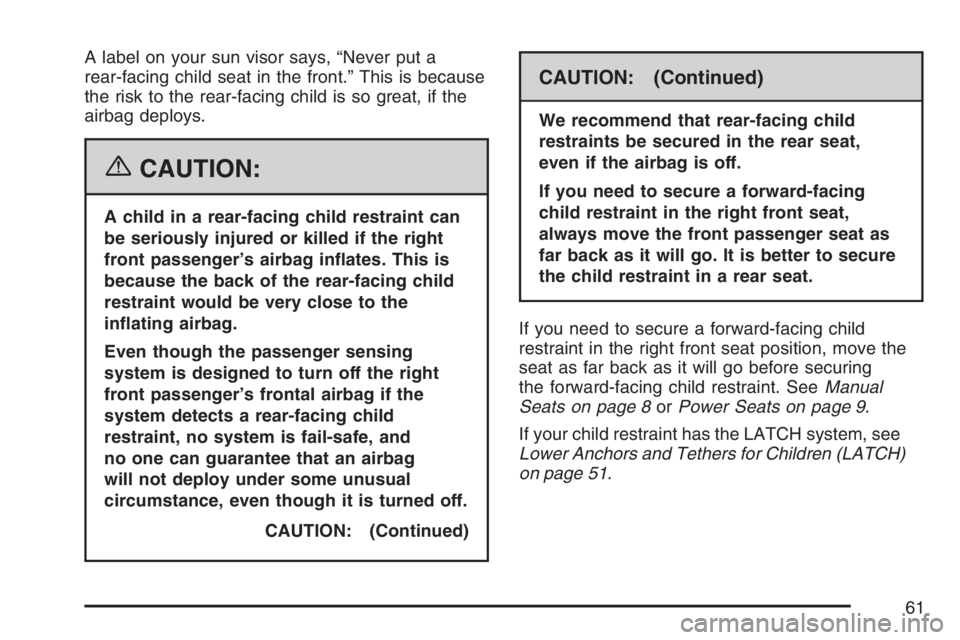
A label on your sun visor says, “Never put a
rear-facing child seat in the front.” This is because
the risk to the rear-facing child is so great, if the
airbag deploys.
{CAUTION:
A child in a rear-facing child restraint can
be seriously injured or killed if the right
front passenger’s airbag in�ates. This is
because the back of the rear-facing child
restraint would be very close to the
in�ating airbag.
Even though the passenger sensing
system is designed to turn off the right
front passenger’s frontal airbag if the
system detects a rear-facing child
restraint, no system is fail-safe, and
no one can guarantee that an airbag
will not deploy under some unusual
circumstance, even though it is turned off.
CAUTION: (Continued)
CAUTION: (Continued)
We recommend that rear-facing child
restraints be secured in the rear seat,
even if the airbag is off.
If you need to secure a forward-facing
child restraint in the right front seat,
always move the front passenger seat as
far back as it will go. It is better to secure
the child restraint in a rear seat.
If you need to secure a forward-facing child
restraint in the right front seat position, move the
seat as far back as it will go before securing
the forward-facing child restraint. SeeManual
Seats on page 8orPower Seats on page 9.
If your child restraint has the LATCH system, see
Lower Anchors and Tethers for Children (LATCH)
on page 51.
61
Page 62 of 480
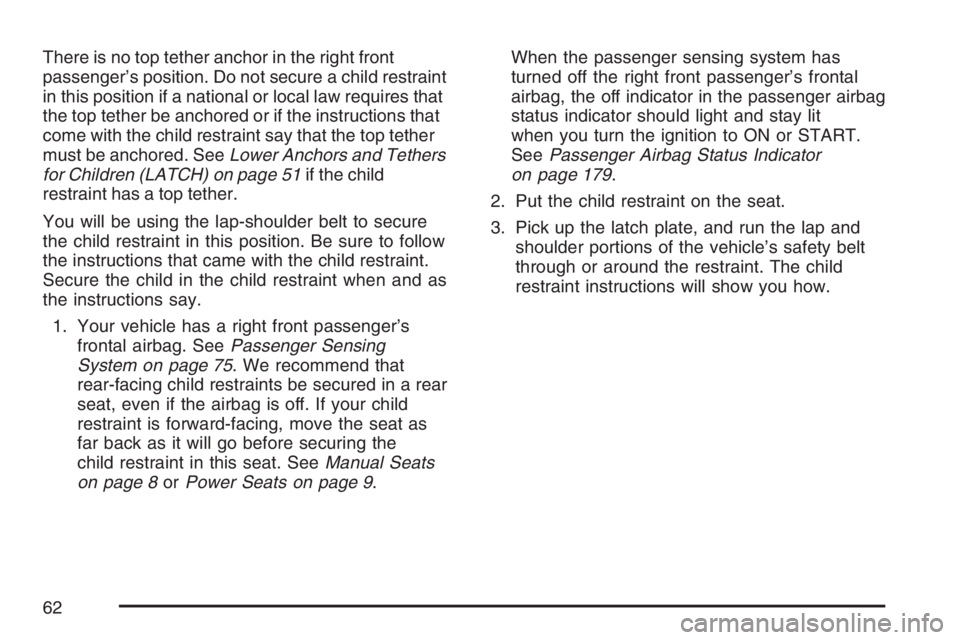
There is no top tether anchor in the right front
passenger’s position. Do not secure a child restraint
in this position if a national or local law requires that
the top tether be anchored or if the instructions that
come with the child restraint say that the top tether
must be anchored. SeeLower Anchors and Tethers
for Children (LATCH) on page 51if the child
restraint has a top tether.
You will be using the lap-shoulder belt to secure
the child restraint in this position. Be sure to follow
the instructions that came with the child restraint.
Secure the child in the child restraint when and as
the instructions say.
1. Your vehicle has a right front passenger’s
frontal airbag. SeePassenger Sensing
System on page 75. We recommend that
rear-facing child restraints be secured in a rear
seat, even if the airbag is off. If your child
restraint is forward-facing, move the seat as
far back as it will go before securing the
child restraint in this seat. SeeManual Seats
on page 8orPower Seats on page 9.When the passenger sensing system has
turned off the right front passenger’s frontal
airbag, the off indicator in the passenger airbag
status indicator should light and stay lit
when you turn the ignition to ON or START.
SeePassenger Airbag Status Indicator
on page 179.
2. Put the child restraint on the seat.
3. Pick up the latch plate, and run the lap and
shoulder portions of the vehicle’s safety belt
through or around the restraint. The child
restraint instructions will show you how.
62
Page 63 of 480
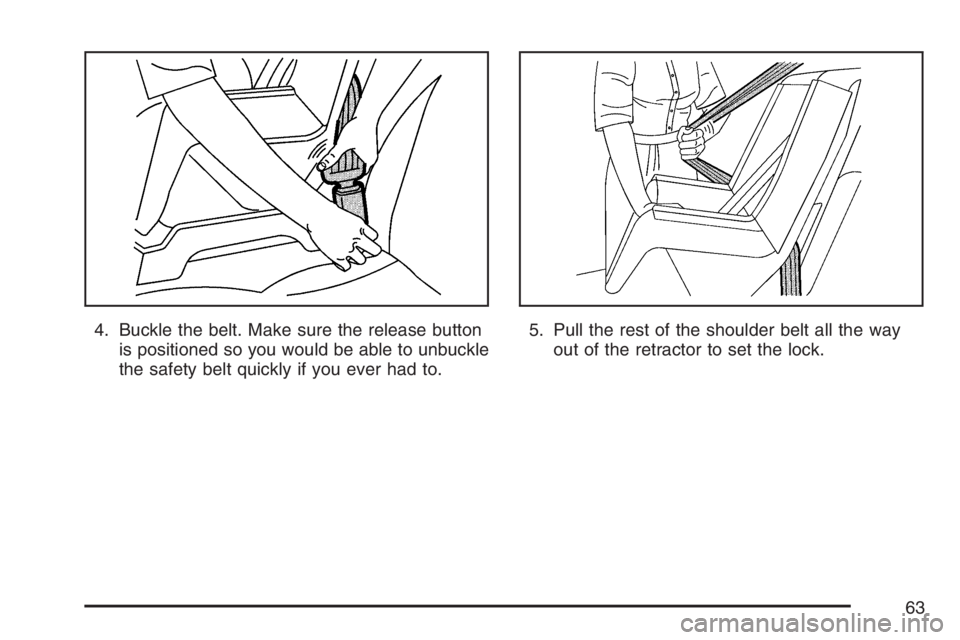
4. Buckle the belt. Make sure the release button
is positioned so you would be able to unbuckle
the safety belt quickly if you ever had to.5. Pull the rest of the shoulder belt all the way
out of the retractor to set the lock.
63
Page 64 of 480
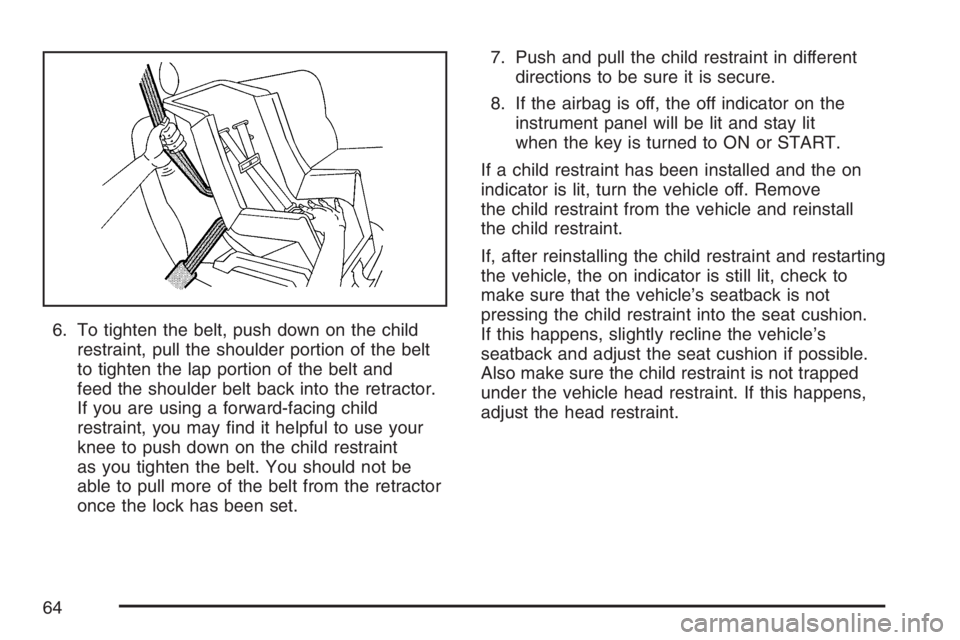
6. To tighten the belt, push down on the child
restraint, pull the shoulder portion of the belt
to tighten the lap portion of the belt and
feed the shoulder belt back into the retractor.
If you are using a forward-facing child
restraint, you may �nd it helpful to use your
knee to push down on the child restraint
as you tighten the belt. You should not be
able to pull more of the belt from the retractor
once the lock has been set.7. Push and pull the child restraint in different
directions to be sure it is secure.
8. If the airbag is off, the off indicator on the
instrument panel will be lit and stay lit
when the key is turned to ON or START.
If a child restraint has been installed and the on
indicator is lit, turn the vehicle off. Remove
the child restraint from the vehicle and reinstall
the child restraint.
If, after reinstalling the child restraint and restarting
the vehicle, the on indicator is still lit, check to
make sure that the vehicle’s seatback is not
pressing the child restraint into the seat cushion.
If this happens, slightly recline the vehicle’s
seatback and adjust the seat cushion if possible.
Also make sure the child restraint is not trapped
under the vehicle head restraint. If this happens,
adjust the head restraint.
64
Page 65 of 480
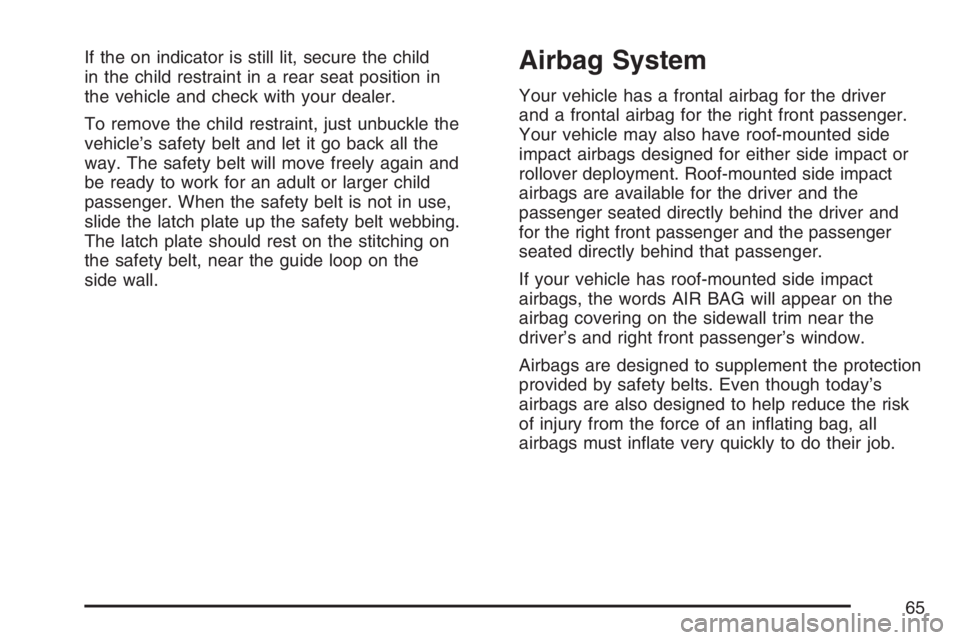
If the on indicator is still lit, secure the child
in the child restraint in a rear seat position in
the vehicle and check with your dealer.
To remove the child restraint, just unbuckle the
vehicle’s safety belt and let it go back all the
way. The safety belt will move freely again and
be ready to work for an adult or larger child
passenger. When the safety belt is not in use,
slide the latch plate up the safety belt webbing.
The latch plate should rest on the stitching on
the safety belt, near the guide loop on the
side wall.Airbag System
Your vehicle has a frontal airbag for the driver
and a frontal airbag for the right front passenger.
Your vehicle may also have roof-mounted side
impact airbags designed for either side impact or
rollover deployment. Roof-mounted side impact
airbags are available for the driver and the
passenger seated directly behind the driver and
for the right front passenger and the passenger
seated directly behind that passenger.
If your vehicle has roof-mounted side impact
airbags, the words AIR BAG will appear on the
airbag covering on the sidewall trim near the
driver’s and right front passenger’s window.
Airbags are designed to supplement the protection
provided by safety belts. Even though today’s
airbags are also designed to help reduce the risk
of injury from the force of an in�ating bag, all
airbags must in�ate very quickly to do their job.
65
Page 66 of 480
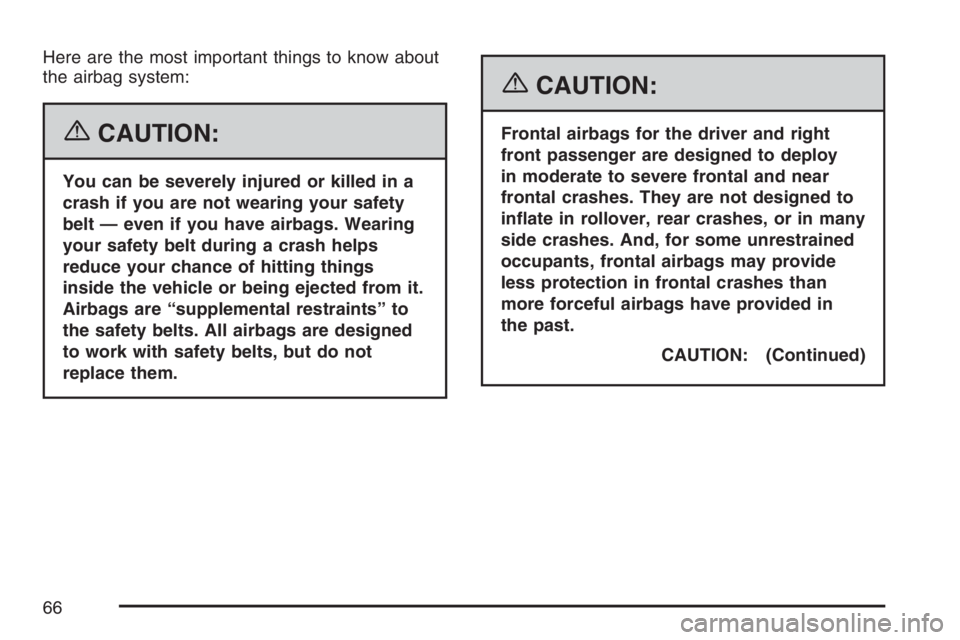
Here are the most important things to know about
the airbag system:
{CAUTION:
You can be severely injured or killed in a
crash if you are not wearing your safety
belt — even if you have airbags. Wearing
your safety belt during a crash helps
reduce your chance of hitting things
inside the vehicle or being ejected from it.
Airbags are “supplemental restraints” to
the safety belts. All airbags are designed
to work with safety belts, but do not
replace them.
{CAUTION:
Frontal airbags for the driver and right
front passenger are designed to deploy
in moderate to severe frontal and near
frontal crashes. They are not designed to
in�ate in rollover, rear crashes, or in many
side crashes. And, for some unrestrained
occupants, frontal airbags may provide
less protection in frontal crashes than
more forceful airbags have provided in
the past.
CAUTION: (Continued)
66
Page 67 of 480
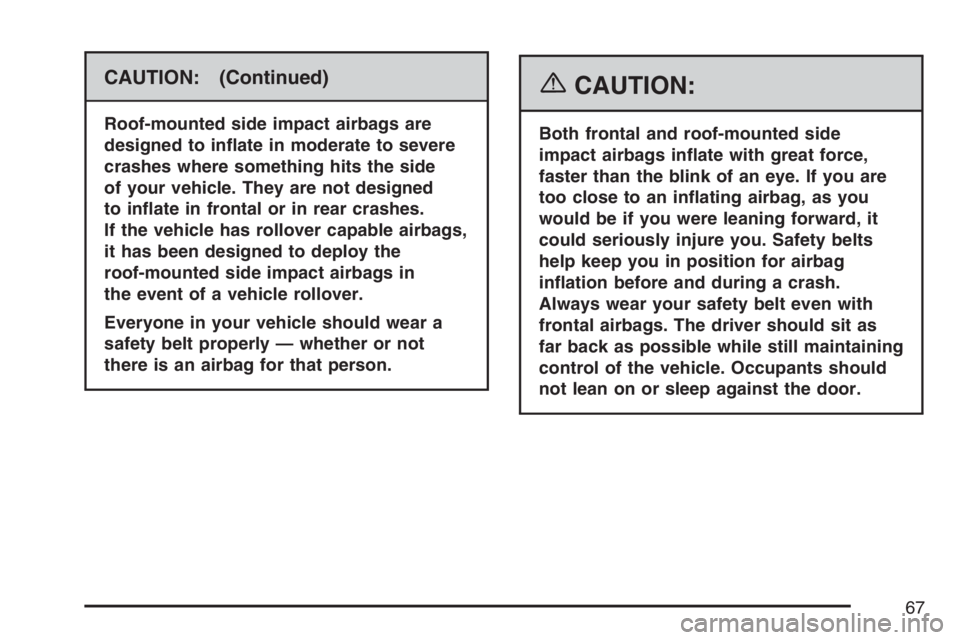
CAUTION: (Continued)
Roof-mounted side impact airbags are
designed to in�ate in moderate to severe
crashes where something hits the side
of your vehicle. They are not designed
to in�ate in frontal or in rear crashes.
If the vehicle has rollover capable airbags,
it has been designed to deploy the
roof-mounted side impact airbags in
the event of a vehicle rollover.
Everyone in your vehicle should wear a
safety belt properly — whether or not
there is an airbag for that person.
{CAUTION:
Both frontal and roof-mounted side
impact airbags in�ate with great force,
faster than the blink of an eye. If you are
too close to an in�ating airbag, as you
would be if you were leaning forward, it
could seriously injure you. Safety belts
help keep you in position for airbag
in�ation before and during a crash.
Always wear your safety belt even with
frontal airbags. The driver should sit as
far back as possible while still maintaining
control of the vehicle. Occupants should
not lean on or sleep against the door.
67
Page 68 of 480
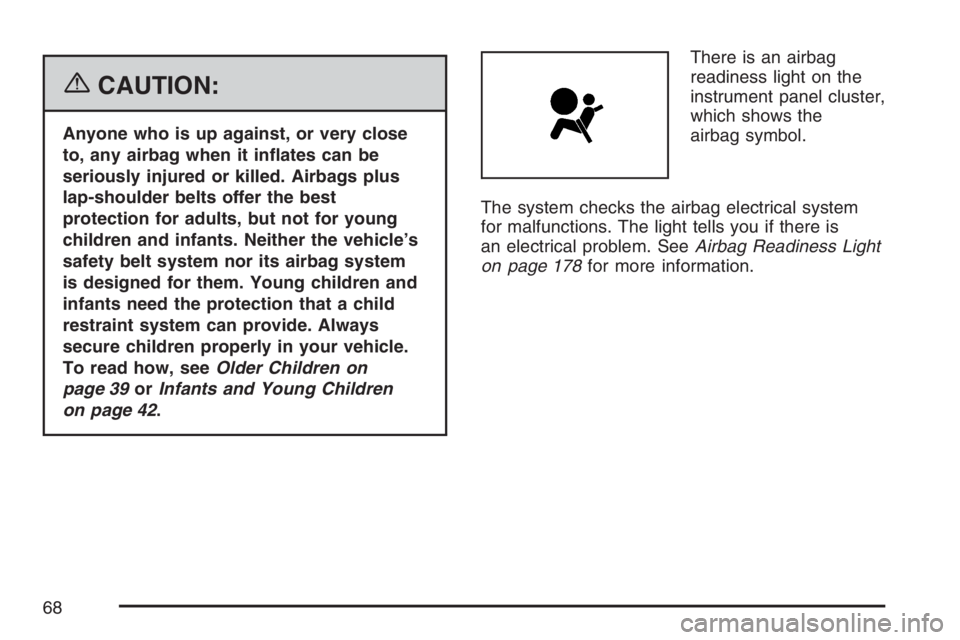
{CAUTION:
Anyone who is up against, or very close
to, any airbag when it in�ates can be
seriously injured or killed. Airbags plus
lap-shoulder belts offer the best
protection for adults, but not for young
children and infants. Neither the vehicle’s
safety belt system nor its airbag system
is designed for them. Young children and
infants need the protection that a child
restraint system can provide. Always
secure children properly in your vehicle.
To read how, seeOlder Children on
page 39orInfants and Young Children
on page 42.There is an airbag
readiness light on the
instrument panel cluster,
which shows the
airbag symbol.
The system checks the airbag electrical system
for malfunctions. The light tells you if there is
an electrical problem. SeeAirbag Readiness Light
on page 178for more information.
68
Page 69 of 480
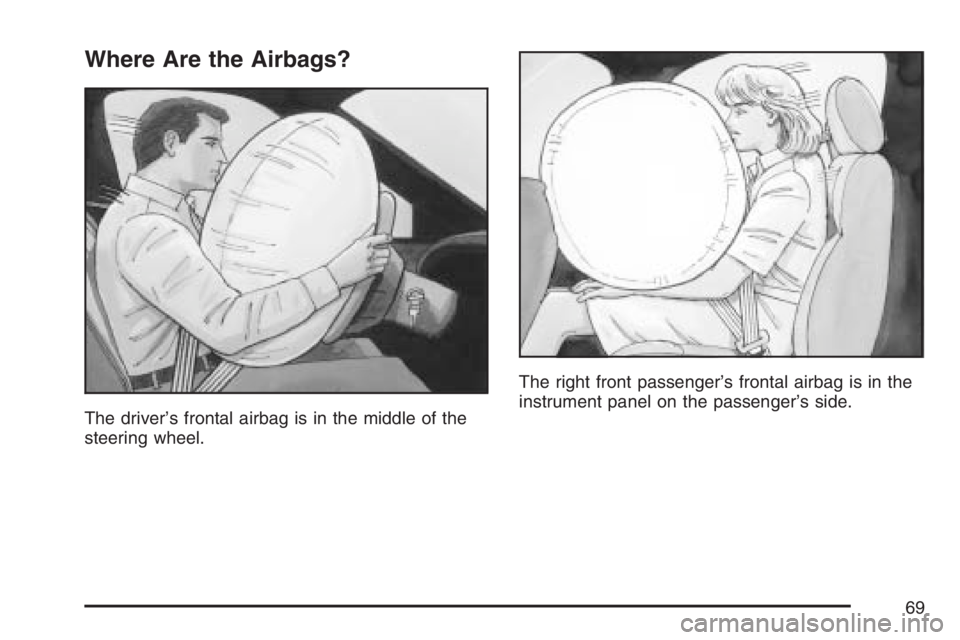
Where Are the Airbags?
The driver’s frontal airbag is in the middle of the
steering wheel.The right front passenger’s frontal airbag is in the
instrument panel on the passenger’s side.
69
Page 70 of 480
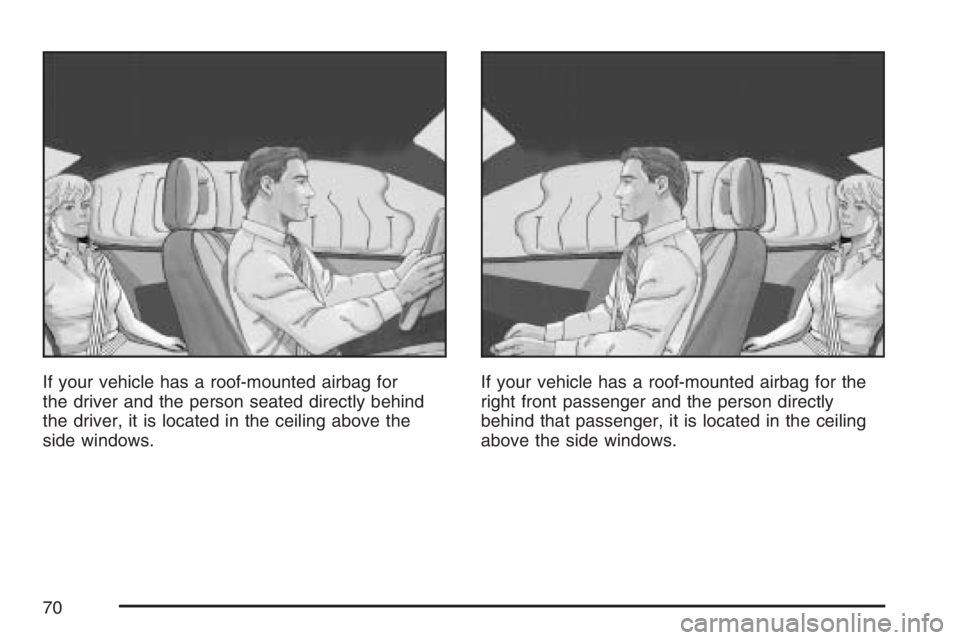
If your vehicle has a roof-mounted airbag for
the driver and the person seated directly behind
the driver, it is located in the ceiling above the
side windows.If your vehicle has a roof-mounted airbag for the
right front passenger and the person directly
behind that passenger, it is located in the ceiling
above the side windows.
70